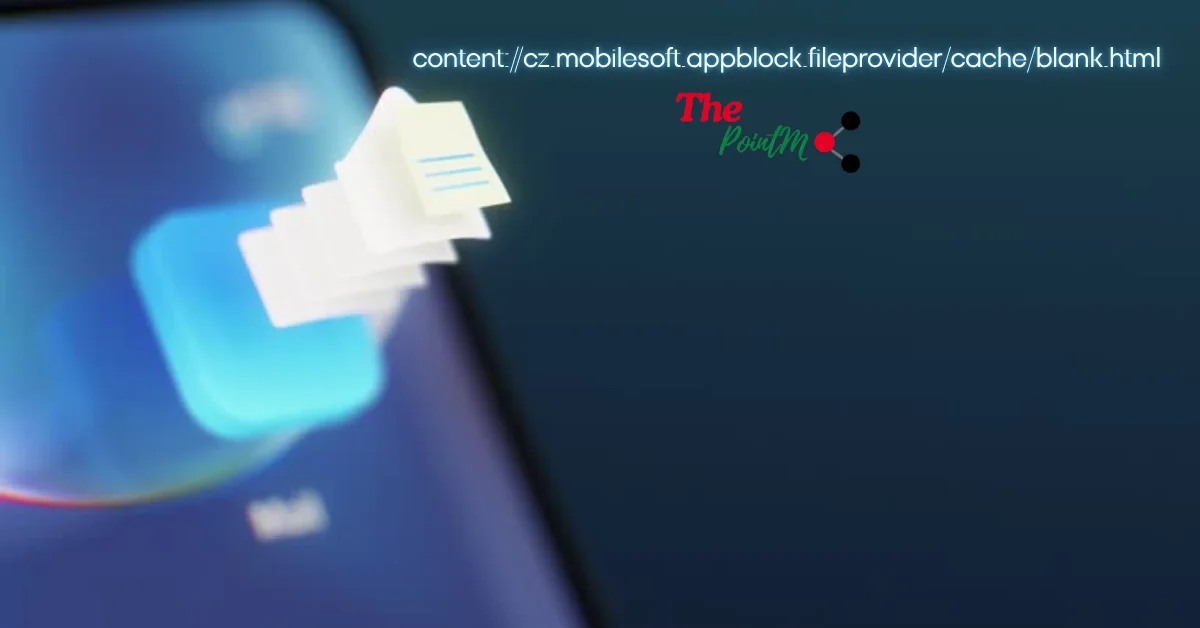In the vast world of Android development, there are numerous hidden gems that contribute to app functionality and user experience. One such gem is the intriguing URL: content://cz.mobilesoft.appblock.fileprovider/cache/blank.html. While it may seem like a simple string of text at first glance, this specific content URI plays an essential role in how apps manage data and interact with users. Understanding its significance can open doors to more efficient app usage and enhanced security measures for your mobile device. Let’s dive deeper into why this seemingly obscure URL matters so much for Android users today.
Understanding the Content://cz.mobilesoft.appblock.fileprovider/cache/blank.html URL
The URL content://cz.mobilesoft.appblock.fileprovider/cache/blank.html represents a specific location within an Android app’s file system. It operates under the Content Provider framework, which allows apps to share data securely.
This particular URI points to a cached HTML file that may be utilized by the AppBlock application. The “cache” part indicates it stores temporary data for quick access, enhancing load times and overall performance.
When you encounter this URL, it signals that the app is fetching or displaying information stored locally. This functionality optimizes user experience by minimizing network requests and ensuring smoother interactions within the app environment.
Understanding how such URIs work empowers users and developers alike. It fosters greater insight into how applications manage their data while providing opportunities for improved design and security practices in future development efforts.
How it Affects Android Users
The content://cz.mobilesoft.appblock.fileprovider/cache/blank.html URL plays an essential role in how Android users manage app data. It allows apps to access shared resources safely without exposing sensitive information. This functionality is crucial for maintaining user privacy.
When users interact with applications utilizing this content provider, they benefit from a streamlined experience. Apps can quickly retrieve cached files and display relevant information without lag, enhancing overall performance.
However, not all Android users are aware of the implications of such URLs. For some, it may seem technical or irrelevant. Yet, understanding these elements can empower them to make informed choices about their app usage and permissions.
Moreover, as more apps adopt similar structures, familiarity with these file paths might become commonplace among savvy users. Engaged Android enthusiasts will appreciate the nuances that come with managing various types of content providers effectively.
Benefits of Using the Content Provider
Using the content provider system in Android offers numerous advantages for both developers and users. One of the main benefits is improved data sharing between apps. This allows applications to access and modify shared data seamlessly, enhancing user experience.
Another significant perk is consistent data management. Content providers help maintain a structured way to store, retrieve, and update information across different applications without duplicating efforts.
Additionally, they ensure better security protocols are in place. By defining permissions at various levels, developers can control who accesses sensitive information.
Moreover, content providers promote modular app design. This separation simplifies maintenance and updates since changes can be made within one module without affecting others directly.
Using content providers enhances performance by caching data efficiently. This reduces load times while providing faster interactions for end-users as they navigate through their favorite apps.
Risks and Security Concerns
When dealing with content://cz.mobilesoft.appblock.fileprovider/cache/blank.html, users should be aware of potential risks. The use of content providers can expose sensitive data if not handled properly.
Unauthorized access is a significant concern. Malicious apps may exploit vulnerabilities to gain entry into cached files, leading to data breaches. This is particularly problematic for applications that store personal information.
Moreover, improper permissions can leave your device vulnerable. If an app requests excessive permissions without justification, it might misuse the access granted by unsuspecting users.
Data integrity is another issue to consider. Cached files could become corrupted or altered by unauthorized entities. This creates uncertainty about the authenticity of what you see and interact with on your device.
Implementing robust security protocols becomes crucial in mitigating these threats and ensuring user safety while navigating through Android’s file provider system.
Tips for Using Content Providers Safely
When using content providers, always ensure that you understand their permissions. Review the app’s requirements before granting access to your data.
Keep your software updated. Regular updates can patch vulnerabilities that may expose your information.
Limit the amount of sensitive data shared through content providers. Only share what is necessary for the app’s functionality.
Use secure coding practices when developing apps that utilize content providers. This helps reduce risks associated with unauthorized access or data leaks.
Regularly audit and monitor applications on your device. Check for unusual behavior or excessive permissions that seem unnecessary.
Consider using alternative methods for sharing data if you’re unsure about a provider’s security measures. Sometimes simpler solutions are just as effective without compromising safety.
Alternative Solutions for App Data Management
When considering alternatives for app data management, cloud storage solutions are a popular choice. Services like Google Drive or Dropbox offer flexibility and accessibility across devices.
Another option is utilizing local databases such as SQLite. This lightweight database allows apps to manage structured data efficiently on the device itself.
For those prioritizing privacy, encryption software can safeguard confidential data before storage, providing an added defense against unauthorized access.
Additionally, file synchronization services enable seamless updates across multiple platforms without manual intervention. Tools like Sync.com keep your data consistent and safe.
Exploring third-party applications designed specifically for data organization can simplify complex tasks while providing user-friendly interfaces. These options cater to various needs and preferences in managing app-related information effectively.
Conclusion
The content://cz.mobilesoft.appblock.fileprovider/cache/blank.html URL plays a significant role in the Android ecosystem. Understanding how it works helps users navigate app data management more effectively. This URL serves as an entry point for accessing cached files, making it essential for performance and user experience.
Android users can benefit from this functionality by enjoying smoother app interactions and faster load times. However, it’s crucial to remain aware of potential risks associated with using content providers. Security concerns could arise if sensitive information is mishandled or accessible through these URLs.
To mitigate these risks, adopting safe practices is advisable when utilizing content providers. Users should stay informed about permissions granted to apps and regularly review their privacy settings.
For those looking for alternative solutions, various methods exist for managing app data securely without relying solely on the Android file provider system. Exploring different options can lead to better control over personal information while ensuring optimal application performance.
Understanding all aspects surrounding content://cz.mobilesoft.appblock.fileprovider/cache/blank.html empowers users to make informed decisions regarding their mobile experience and security.

